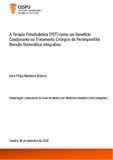| dc.contributor.advisor | SALAZAR, FILOMENA DA GLÓRIA BARROS ALVES | |
| dc.contributor.author | Ribeiro, Sara Filipa Martinho | |
| dc.date.accessioned | 2022-02-10T13:26:30Z | |
| dc.date.available | 2022-02-10T13:26:30Z | |
| dc.date.issued | 2021 | |
| dc.identifier.uri | http://hdl.handle.net/20.500.11816/3884 | |
| dc.description.abstract | A periimplantite baseia-se numa doença inflamatória que afeta os tecidos moles e duros em volta do implante, originando bolsas periodontais e a consequente perda óssea, que se não obtiver tratamento adequado pode levar à perda do mesmo.
Os microrganismos que nele habitam são considerados os principais fatores etiológicos.
Esta doença apresenta como manifestações clínicas o sangramento, aumento da profundidade de sondagem, perda de inserção clínica, perda óssea. Então, a remoção dos depósitos bacterianos é essencial para o tratamento das infeções periimplantares.
Os tratamentos convencionais passam pelas terapias cirúrgicas e não cirúrgicas associados à utilização de antissépticos e antibióticos, portanto tem vindo a ser discutida novas terapias para o tratamento da periimplantite, como é o caso da Terapia Fotodinâmica como uma coadjuvante à terapia cirúrgica.
O objetivo deste estudo compreendeu na realização de uma revisão sobre avaliar o uso da terapia fotodinâmica como um benefício coadjuvante no tratamento cirúrgico da periimplantite.
Foi realizada uma pesquisa bibliográfica na PUBMED e na EbscoHost, utilizando as seguintes palavras-chave: periimplantiites AND treatment AND surgical treatment AND photodynamic therapy OR PDT OR Photechemotherapy. Na pesquisa foram identificados 80 estudos, dos quais 12 foram incluídos após a leitura integral e foi adicionado manualmente 3 artigos para fundamentação teórica.
Na análise dos estudos conclui-se que apesar da Terapia Fotodinâmica ter se mostrado uma terapia promissora para a periimplantite, continuam a ser necessários mais estudos sobre o tema. | pt_PT |
| dc.description.abstract | Peri-implantitis is based on an inflammatory disease that affects the soft and hard tissues around the implant, causing periodontal pockets and consequent bone loss, which, if not properly treated, can lead to its loss.
The microorganisms that inhabit it are considered the main etiological factors.
The clinical manifestations of this disease are bleeding, increased probing depth, clinical attachment loss, bone loss. Therefore, removal of bacterial deposits is essential for the treatment of peri-implant infections.
Conventional treatments include surgical and non-surgical therapies associated with the use of antiseptics and antibiotics, so new therapies for the treatment of periimplantitis have been discussed, such as Photodynamic Therapy as an adjunct to surgical therapy.
The aim of this study was to carry out a review on evaluating the use of photodynamic therapy as an adjunctive benefit in the surgical treatment of periimplantitis.
A literature search was carried out in PUBMED and EbscoHost, using the following keywords: periimplantitis AND treatment AND surgical treatment AND photodynamic therapy OR PDT OR Photechemotherapy. In the search, 80 studies were identified, of which 12 were included after full reading and 3 articles were manually added for theoretical foundation.
In the analysis of the studies, it is concluded that although Photodynamic Therapy has shown to be a promising therapy for periimplantitis, further studies on the subject are still needed. | pt_PT |
| dc.language.iso | por | pt_PT |
| dc.rights | info:eu-repo/semantics/openAccess | pt_PT |
| dc.subject | Periimplantitis | pt_PT |
| dc.subject | Treatment | pt_PT |
| dc.subject | Surgical treatment | pt_PT |
| dc.subject | Photodynamic therapy | pt_PT |
| dc.title | A Terapia Fotodinâmica (PDT) como um Benefício Coadjuvante do Tratamento Cirúrgico da Periimplantite: Revisão Sistemática Integrativa | pt_PT |
| dc.type | info:eu-repo/semantics/masterThesis | pt_PT |
| dc.identifier.tid | 202911900 | pt_PT |
| thesis.degree.name | Mestrado em Medicina Dentária | pt_PT |

